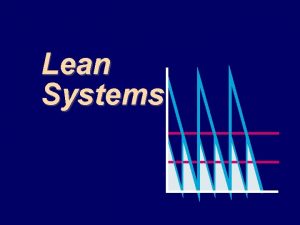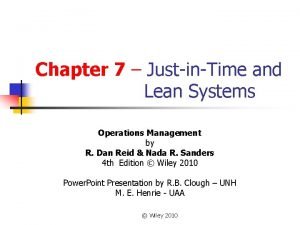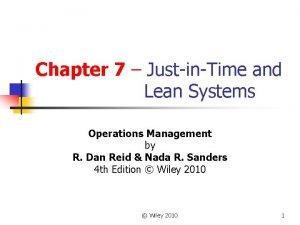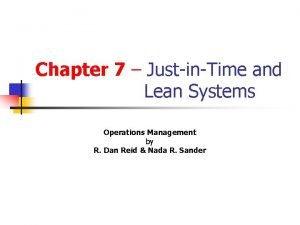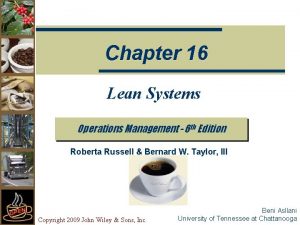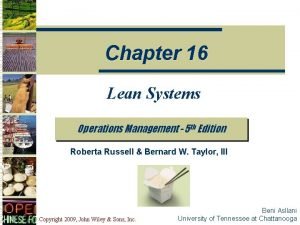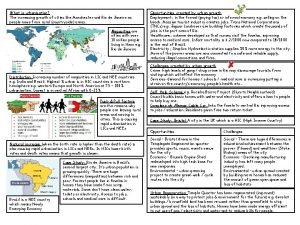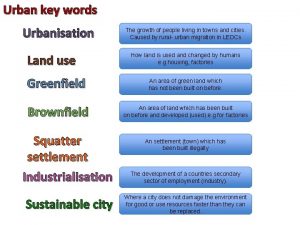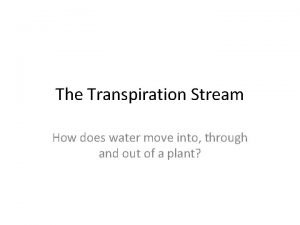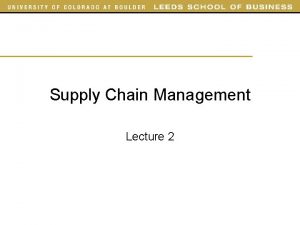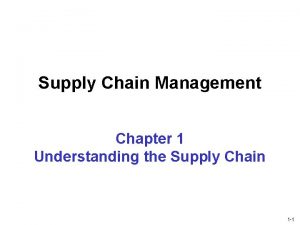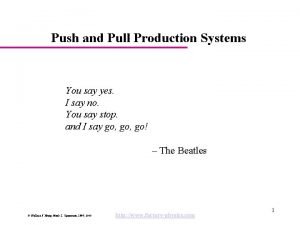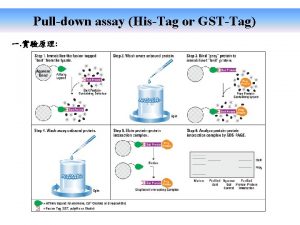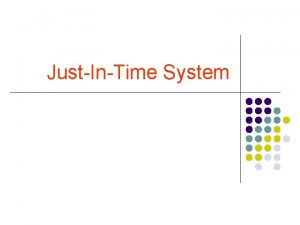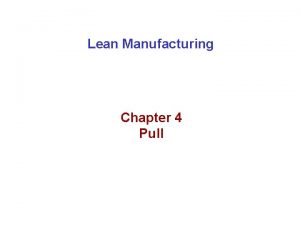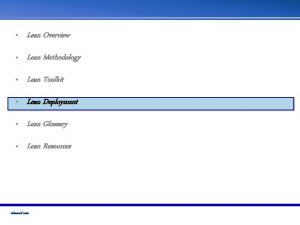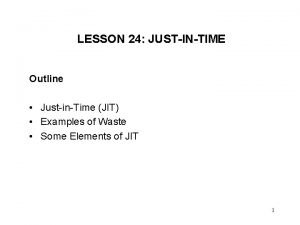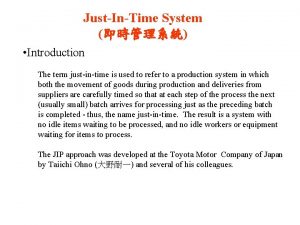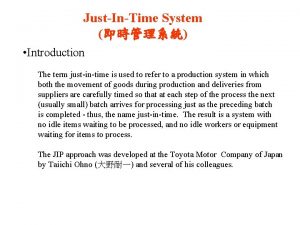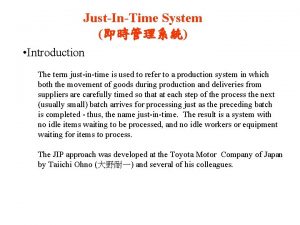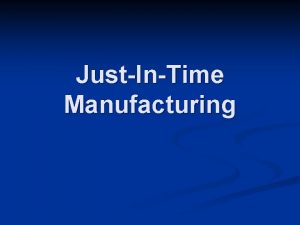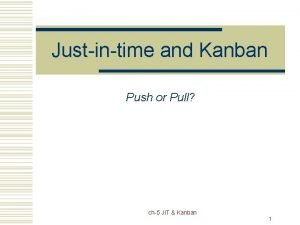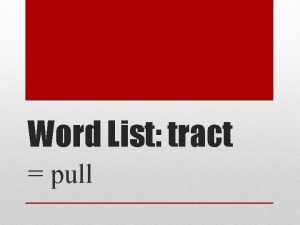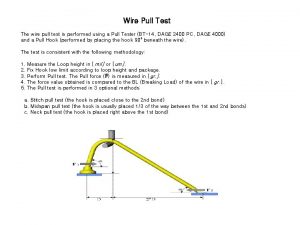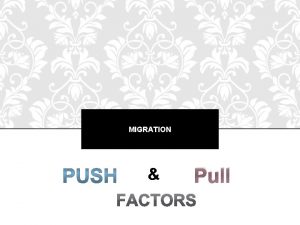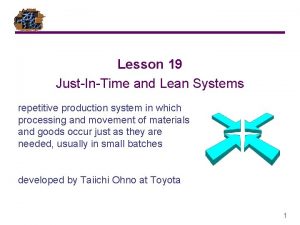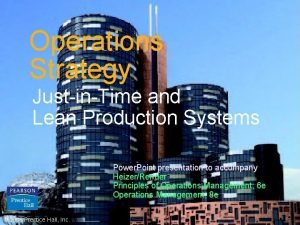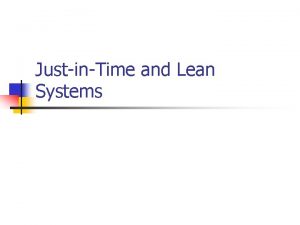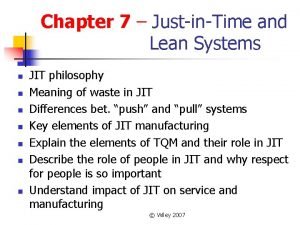Lean Systems Characteristics of Lean Systems JustinTime Pull






























- Slides: 30

Lean Systems

Characteristics of Lean Systems: Just-in-Time · Pull method of materials flow · Consistently high quality · Small lot sizes · Uniform workstation loads · Standardized components and work methods · Close supplier ties · Flexible workforce · Line flows · Automated production · Preventive maintenance

Lot Size and Cycle Inventory

Lot Size and Cycle Inventory 100 – On-hand inventory Average cycle inventory 75 – Lot size = 100 50 – 25 – 0– Figure 16. 1 5 10 15 Time (hours) 20 25 30

Lot Size and Cycle Inventory 100 – On-hand inventory Average cycle inventory 75 – Lot size = 100 50 – 25 – 0– Figure 16. 1 5 10 15 Time (hours) 20 25 30

Lot Size and Cycle Inventory 100 – On-hand inventory Average cycle inventory 75 – Lot size = 100 50 – Lot size = 50 25 – 0– Figure 16. 1 5 10 15 Time (hours) 20 25 30

Lot Size and Cycle Inventory 100 – On-hand inventory Average cycle inventory 75 – Lot size = 100 50 – Lot size = 50 25 – 0– Figure 16. 1 5 10 15 Time (hours) 20 25 30

Lot Size and Cycle Inventory 100 – On-hand inventory Average cycle inventory 75 – Lot size = 100 50 – Lot size = 50 25 – 0– Figure 16. 1 5 10 15 Time (hours) 20 25 30

Continuous Improvement with Lean Systems Scrap Figure 16. 2 Unreliable suppliers Capacity imbalance

Single-Card Kanban System

Single-Card Kanban System Receiving post Kanban card for product 1 Kanban card for product 2 Storage area Empty containers Assembly line 1 O 2 O 1 Fabrication cell O 2 O 3 Assembly line 2 Full containers Figure 16. 3

Single-Card Kanban System Receiving post Kanban card for product 1 Kanban card for product 2 Storage area Empty containers Assembly line 1 O 2 O 1 Fabrication cell O 2 O 3 Assembly line 2 Full containers Figure 16. 3

Single-Card Kanban System Receiving post Kanban card for product 1 Kanban card for product 2 Storage area Empty containers Assembly line 1 O 2 O 1 Fabrication cell O 2 O 3 Assembly line 2 Full containers Figure 16. 3

Single-Card Kanban System Receiving post Kanban card for product 1 Kanban card for product 2 Storage area Empty containers Assembly line 1 O 2 O 1 Fabrication cell O 2 O 3 Assembly line 2 Full containers Figure 16. 3

Single-Card Kanban System Receiving post Kanban card for product 1 Kanban card for product 2 Storage area Empty containers Assembly line 1 O 2 O 1 Fabrication cell O 2 O 3 Assembly line 2 Full containers Figure 16. 3

Single-Card Kanban System Receiving post Kanban card for product 1 Kanban card for product 2 Storage area Empty containers Assembly line 1 O 2 O 1 Fabrication cell O 2 O 3 Assembly line 2 Full containers Figure 16. 3

Single-Card Kanban System Receiving post Kanban card for product 1 Kanban card for product 2 Storage area Empty containers Assembly line 1 O 2 O 1 Fabrication cell O 2 O 3 Assembly line 2 Full containers Figure 16. 3

Single-Card Kanban System Location: Part Number: 6 Aisle 5 Bin 47 1234567 Z KANBAN Lot Quantity: WS 83 ü ü Supplier: ü WS 116 ü Each container must have a card Assembly always withdraws from fabrication (pull system) Containers cannot be moved without a kanban Containers should contain the same number of parts Only good parts are passed along Production should not exceed authorization Customer: ü ü

Number of Containers

Number of Containers Westerville Auto Parts d = 2000 units/day p = 0. 02 day a = 0. 10 w = 0. 08 day c = 22 units k= d( w + p )( 1 + a ) c Example 16. 1

Number of Containers Westerville Auto Parts d = 2000 units/day p = 0. 02 day a = 0. 10 w = 0. 08 day c = 22 units k= 2000( 0. 08 + 0. 02 )( 1 + 0. 10 ) 22 Example 16. 1

Number of Containers Westerville Auto Parts d = 2000 units/day p = 0. 02 day a = 0. 10 w = 0. 08 day c = 22 units k= 2000( 0. 08 + 0. 02 )( 1 + 0. 10 ) 22 Example 16. 1

Number of Containers Westerville Auto Parts d = 2000 units/day p = 0. 02 day a = 0. 10 w = 0. 08 day c = 22 units k = 10 containers Example 16. 1

Number of Containers Westerville Auto Parts d = 2000 units/day p = 0. 02 day a = 0. 10 w = 0. 06 day c = 22 units k = 10 containers k= d( w + p )( 1 + a ) c Example 16. 1

Number of Containers Westerville Auto Parts d = 2000 units/day p = 0. 02 day a = 0. 10 w = 0. 06 day c = 22 units k = 10 containers k= 2000(0. 06 + 0. 02)(1. 10) 22 Example 16. 1

Number of Containers Westerville Auto Parts d = 2000 units/day p = 0. 02 day a = 0. 10 w = 0. 06 day c = 22 units k = 10 containers k= 2000(0. 06 + 0. 02)(1. 10) 22 Example 16. 1

Number of Containers Westerville Auto Parts d = 2000 units/day p = 0. 02 day a = 0. 10 w = 0. 06 day c = 22 units k = 10 containers k = 8 containers Example 16. 1

Number of Containers Westerville Auto Parts d = 2000 units/day p = 0. 02 day a = 0. 10 w = 0. 06 day c = 22 units k = 10 containers k = 8 containers Figure 16. 4

Lean Systems in Services · Consistently high quality · Uniform facility loads · Standardized work methods · Close supplier ties · Flexible workforce · Automation · Preventive maintenance · Pull method of materials flow · Line flows

Operational Benefits · Reduce space requirements · Reduce inventory investment · Reduce lead times · Increase labor productivity · Increase equipment utilization · Reduce paperwork and simple · · · planning systems Valid priorities for scheduling Workforce participation Increase product quality
 Justintime production
Justintime production Importance of angle of pull
Importance of angle of pull Pull signal
Pull signal Lean system characteristics
Lean system characteristics Lean operations and systems
Lean operations and systems Lean systems operations management
Lean systems operations management Lean systems operations management
Lean systems operations management A production kanban authorizes a worker to:
A production kanban authorizes a worker to: Modina spirit
Modina spirit Lean systems operations management
Lean systems operations management Push and pull factors of urbanisation
Push and pull factors of urbanisation Push and pull factors of urbanisation
Push and pull factors of urbanisation Gravity force
Gravity force Centrifugal movement geography
Centrifugal movement geography Urban key house
Urban key house To root out and to pull down
To root out and to pull down How does it move
How does it move Booker t washington bootstraps
Booker t washington bootstraps Push pull in supply chain
Push pull in supply chain Cycle view and push pull view
Cycle view and push pull view Wideband impedance matching
Wideband impedance matching Strategie promocji
Strategie promocji Push and pull factors of urbanisation
Push and pull factors of urbanisation Push and pull scenarios
Push and pull scenarios The homestead act definition
The homestead act definition Conwip
Conwip Gst pull down
Gst pull down I can reach my own brass ring and pull it for me
I can reach my own brass ring and pull it for me Push vs pull promotional strategy
Push vs pull promotional strategy Pull factors prevent duty
Pull factors prevent duty Pull de trabajo
Pull de trabajo



